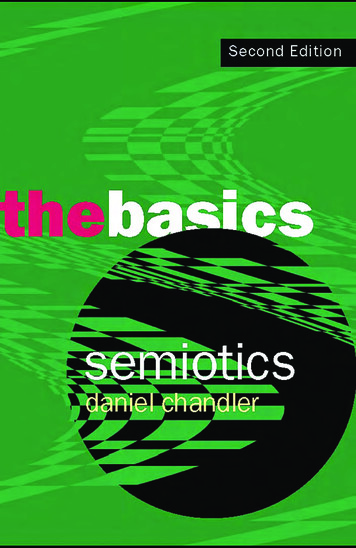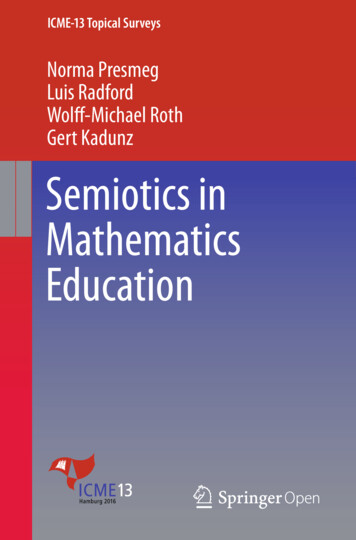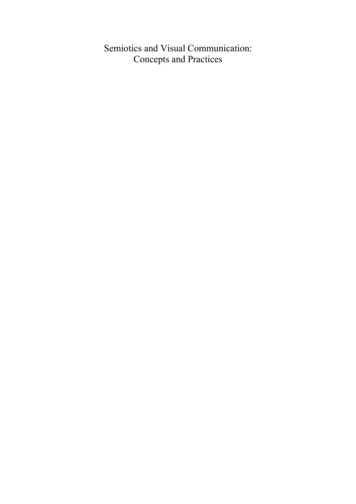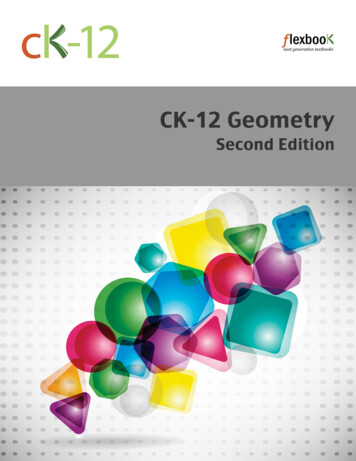
Transcription
EMIOTICSTHE BASICSFollowing the success of the first edition, Semiotics: the Basics hasbeen revised to include new material on the development of semiotics from Saussure to contemporary socio-semiotics. This secondedition is fully updated with an extended index, glossary, and furtherreading section. Using jargon-free language and lively up-to-dateexamples, this book demystifies this highly interdisciplinary subjectand addresses questions such as: What is a sign?Which codes do we take for granted?What is a text?How can semiotics be used in textual analysis?Who are Saussure, Peirce, Barthes and Jakobson – and whyare they important?The new edition of Semiotics: the Basics provides an interesting andaccessible introduction to this field of study, and is a must-have foranyone coming to semiotics for the first time.Daniel Chandler is a Lecturer in the department of Theatre, Filmand Television Studies at the University of Wales, Aberystwyth.
ALSO AVAILABLE FROM ROUTLEDGELANGUAGE: THE BASICS (SECOND EDITION)R. L. TRASKPSYCHOLINGUISTICS: THE KEY CONCEPTSJOHN FIELDKEY CONCEPTS IN LANGUAGE AND LINGUISTICSR.L. TRASKTHE ROUTLEDGE COMPANION TO SEMIOTICS AND LINGUISTICSPAUL COBLEYCOMMUNICATION, CULTURE AND MEDIA STUDIES:THE KEY CONCEPTSJOHN HARTLEY
EMIOTICSTHE BASICSSECOND EDITIONDaniel Chandler
First published 2002 by Routledge2 Park Square, Milton Park, Abingdon,Oxon OX14 4RNSimultaneously published in the USA and Canadaby Routledge270 Madison Ave, New York, NY 10016Reprinted 2002, 2004 (twice), 2005Routledge is an imprint of the Taylor & Francis Group, an informa businessSecond edition 2007 2002, 2007 Daniel ChandlerThe author has asserted his moral rights in relation to this work inaccordance with the Copyright, Designs and Patents Act 1988.This edition published in the Taylor & Francis e-Library, 2007.“To purchase your own copy of this or any of Taylor & Francis or Routledge’scollection of thousands of eBooks please go to www.eBookstore.tandf.co.uk.”All rights reserved. No part of this book may be reprinted or reproducedor utilized in any form or by any electronic, mechanical, or other means,now known or hereafter invented, including photocopying and recording,or in any information storage or retrieval system, without permissionin writing from the publishers.British Library Cataloguing in Publication DataA catalogue record for this book is available from the British LibraryLibrary of Congress Cataloging in Publication DataChandler, Daniel.Semiotics: the basics/Daniel Chandler. – 2nd ed.p. cm.Includes bibliographical references and index.1. Semiotics. I. Title.P99.C463 2007 302.2–dc222006024738ISBN 0–203–01493–6 Master e-book ISBNISBN10: 0–415–36376–4 (hbk)ISBN10: 0–415–36375–6 (pbk)ISBN10: 0–203–01493–6 (ebk)ISBN13: 978–0–415–36376–1 (hbk)ISBN13: 978–0–415–36375–4 (pbk)ISBN13: 978–0–203–01493–6 (ebk)
or Jem‘The subtlety of nature is greater many timesover than the subtlety of argument’Francis Bacon, Novum Organum(1620) Aphorism XXIV
ONTENTSList of finitionsRelation to linguisticsLangue and paroleWhy study semiotics?1 Models of the signThe Saussurean modelTwo sides of a pageThe relational systemArbitrarinessThe Peircean modelRelativitySymbolic modexixiiixvii1258101314171822293538
viiiCONTENTSIconic modeIndexical modeModes not typesChanging relationsDigital and analogueTypes and tokensRematerializing the signHjelmslev’s framework2 Signs and thingsNaming thingsReferentialityModalityThe word is not the thingEmpty signifiers3 Analysing structuresHorizontal and vertical axesThe paradigmatic dimensionThe commutation e semiotic squareThe syntagmatic dimensionSpatial relationsSequential relationsStructural reduction4 Challenging the literalRhetorical tropesMetaphorMetonymySynecdocheIronyMaster tropesDenotation and 43
45672225 CodesTypes of codesPerceptual codesSocial codesTextual codesCodes of realismInvisible editingBroadcast and narrowcast codesInteraction of textual codesCodification6 Textual interactionsModels of communicationThe positioning of the subjectModes of addressReading positionsIntertextualityProblematizing authorshipReading as rewritingNo text is an islandIntratextualityBricolageTypes and degrees of intertextuality7 Prospect and retrospectStructuralist semioticsPoststructuralist semioticsMethodologiesAn ecological and multimodal approachAppendix: key figures and schoolsGoing 1212217221223227235243265293ix
14.24.34.4Saussure’s model of the signConcept and sound patternPlanes of thought and soundThe relations between signsPeirce’s semiotic trianglePeirce’s successive interpretantsSubstance and formSyntagmatic and paradigmatic axesParadigm set for shot sizeMarkedness of some explicit oppositions inonline textsThe semiotic squareLittle Red Riding HoodSubstitution in tropesThe four ‘master tropes’ as a semiotic squareOrders of significationSome connotations of particular fonts14151820303257848997107118125136140141
xiiI L L U S T R AT I O N S6.16.26.36.4Pictorial plaque on Pioneer 10 spacecraft (1972)Saussure’s speech circuitJakobson’s model of communicationJakobson’s six functions of language176179181184
REFACEThe first version of this book was written in 1994 as an online hypertext document. No comparable introductory text on the subject wasavailable at the time so I rashly attempted to create one which suitedmy own purposes and those of my media studies students. It waspartly a way of advancing and clarifying my own understanding ofthe subject. Like many other readers driven by a fascination withmeaning-making, my forays into semiotics had been frustrated bymany of the existing books on the subject which seemed to make itconfusing, dull and deeply obscure. So much of what is written aboutsemiotics is written as if to keep out those who are not already‘members of the club’. This text is intended to be a ‘reader’scompanion’ in approaching more difficult semiotic texts, which sooften assume knowledge of much of the jargon.One of the things that attracted me to semiotics was the wayin which it supports my own enjoyment of crossing the ‘boundaries’of academic disciplines, and of making connections between apparently disparate phenomena. However, I am not a polymath, so there
xivPREFACEare inevitably many subjects which are neglected here. In this text Ihave confined myself to human semiosis, so that this is not the placeto find an introduction to such branches of semiotics as zoosemiotics (the study of the behaviour and communication of animals) orbiosemiotics (the study of the semiotics of biology and of the biological basis of signs). My focus is on the humanities and so there isno mathematical or computer semiotics here either. Even within thehumanities, I did not feel competent to cover topics such as musicalor architectural semiotics. I know that students of some of thesesubjects are among those who have consulted the text, which lendsme some hope that they will find the exploration of general principles of some relevance to their own priorities. To support the needsof such readers, the current edition does include suggestions forfurther reading in some of the subject areas not explicitly coveredwithin the text. The exclusion of certain subjects is not, of course,to suggest that they are any less important to the semiotic enterprise.The unavoidable selectivity of the text invites the productivity of thereader in its deconstruction. Driven by their own purposes, readerswill no doubt be alert to ‘what is conspicuous by its absence’.Semiotics is a huge field, and no treatment of it can claim tobe comprehensive. My attempt to offer a coherent account of somekey concepts is in some ways misleading: there are divergent schoolsof thought in semiotics, and there is remarkably little consensusamong contemporary theorists regarding the scope of the subject,core concepts or methodological tools. In part through terminologysuch as signifier, signified and code, this account reflects the influence of European ‘semiology’; however, it goes beyond theSaussurean legacy of ‘bracketing the referent’ and draws upon thePeircean tradition in recognizing that meanings depend on referential contexts as well as systemic codes. Indeed, in this second edition,I have given more emphasis to the theories of Roman Jakobsonprecisely because his version of structuralism, while both buildingupon and reacting against some of Saussure’s tenets, also adoptedPeircean concepts. Indeed, Jakobson even co-opted Peirce as ‘one ofthe greatest pioneers of structural linguistic analysis’ (Jakobson1952b, 555). Nevertheless, readers seeking an introduction to specifically Peircean semiotics (as opposed to how Peircean concepts have
567222been incorporated into the European structuralist tradition) arereferred elsewhere (Merrell 1995b, Zeman 1997, Deledalle 2000,Merrell 2001).The lengthy treatment of structuralist semiotics in this book isintended to be of particular value to readers who wish to use semiotics as an approach to textual analysis. However, semiotics is farmore than a method of analysing texts, and I hope I will also inspirethe reader’s enthusiasm for exploring some of the fascinating philosophical issues raised by semioticians. In case it is not obvious toreaders, I should declare a social constructionist bias, which is notshared by all semioticians. For semioticians who are (in contrast)drawn towards philosophical realism, reality is wholly external toand independent of how we conceptualize the world. Social constructionism does not entail denying the existence of all external realitybut it does assume that our sign-systems (language and other media)play a major part in ‘the social construction of reality’ (or at least‘the construction of social reality’) and that realities cannot be separated from the sign-systems in which they are experienced. It ishardly surprising when social constructionists are drawn to semiotics, but readers may of course insist on being philosophical realistswithout abandoning semiotics (many semioticians are indeed realists). Note that I make reference here to an opposition betweenidealism and realism, and those who are already well-read in philosophy may object that this sometimes involves a common conflationof two pairings, namely:1. idealism vs. epistemological realism (stances on the issueof whether or not the reality of a physical world is dependent on our minds or language);2. nominalism vs. conceptual realism (stances on the issue ofwhether or not the reality of abstract universals is dependent on our minds or language).Though I may be blamed for oversimplification, such conflationshould be taken to refer to what these pairings have in common:namely, the issue of whether we have any access to what is real apartfrom the mind and language. A potential problem is that I refer toPeirce (as do most commentators, and as did Peirce himself) as axv
xviPREFACE‘realist’ (by which I mean an epistemological realist), but he canalso be labelled a ‘conceptual idealist’ (Sebeok 1994a, 14–15; cf.Merrell 1997, Chapter 4, on Peirce’s ‘objective idealism’).In quoting from the text of Saussure’s Course in GeneralLinguistics, the translation used is that of Roy Harris (Saussure1983), although, following the practice of John Sturrock in usingthis translation (Sturrock 1986, 31, 32), I have retained the terms‘signifier’ and ‘signified’ rather than use Harris’s translation ofsignifiant as ‘signal’ and signifié as ‘signification’. Citations fromPeirce’s Collected Papers (Peirce 1931–58) follow the standard practice of listing the volume number and section number thus: (2.227).Wherever I include quotations within the current text it may beassumed that any italicization was that of the original author exceptwhere I add the note – ‘my emphasis’.A Korean translation of the first edition of this book is currentlyin progress. If there is a demand for translations into other languages,please approach my British publishers.At the time of writing, the online version of this text was at:http://www.aber.ac.uk/media/Documents/S4B/URLs change periodically, so, if necessary, you could use a searchengine to locate it.
CKNOWLEDGEMENTSThe original online text might not have found its way into print ifit were not for the unsolicited encouragement to publish which Ireceived from the philosopher Anthony C. Grayling of BirkbeckCollege, University of London, to whom I am particularly grateful.Special thanks go to my linguist colleagues Bob Morris Jones andMarilyn Martin-Jones for their continued support and encouragement throughout the evolution of this text and of its author. I wouldalso like to thank Vanessa Hogan Vega and Iván Rodrigo Mendizábalfor producing a Spanish translation of an early online version(Chandler 1998), and Maria Constantopoulou of the Athens University of Economics and Business for the Greek translation of theonline version and for several invitations to teach summer schoolsin Greece for MSc students of Marketing and Communication. Thedevelopment of both editions of the book has benefited from theuseful comments of a number of reviewers (although it was notalways possible to address all of their sometimes conflicting points).Special thanks for helpful reviews are due to Juan A. Prieto-Pablos
xviiiACKNOWLEDGEMENTSof the University of Seville, to Ernest W. B. Hess-Lüttich of theUniversity of Berne, to Edward McDonald of the University ofAuckland, and to Guy Cook of the Open University.For specific assistance with the first edition I would like torepeat my thanks to Winfried Nöth of the University of Kassel forhis useful comments on articulation and empty signifiers and toDavid Glen Mick of the University of Wisconsin-Madison, who keptme updated on the semiotics of advertising. For the second edition,thanks to Roderick Munday, Osama Ammar and Tommi Turunen (allof whom have studied with me) for their helpful comments and toJo B. Paoletti of the University of Maryland for tracking down forme the original source of the widely misattributed ‘pink and blue’quotation in Chapter 5. Martin Ryder of the University of Coloradoat Denver suggested weblinks. Figure 4.4 was adapted from diagrams 2001 Software Usability Research Laboratory, Wichita StateUniversity. The image from the plaque on Pioneer 10 shown in Figure6.1 was produced by the Pioneer Project at NASA Ames ResearchCenter and obtained from NASA’s National Space Science DataCenter with the kind assistance of John F. Cooper.The publisher and author have made every effort to trace copyright holders and to obtain permission to publish extracts. Any omissions brought to our attention will be remedied in future editions.
ODUCTIONIf you go into a bookshop and ask an assistant where to find a bookon semiotics, you are likely to meet with a blank look. Even worse,you might be asked to define what semiotics is – which would be abit tricky if you were looking for a beginner’s guide. It’s worse stillif you do know a bit about semiotics, because it can be hard to offera simple definition which is of much use in the bookshop. If you’veever been in such a situation, you’ll probably agree that it’s wise notto ask. Semiotics could be anywhere. The shortest definition is thatit is the study of signs. But that doesn’t leave enquirers much wiser.‘What do you mean by a sign?’ people usually ask next. The kindsof signs that are likely to spring immediately to mind are those whichwe routinely refer to as ‘signs’ in everyday life, such as road signs,pub signs and star signs. If you were to agree with them that semiotics can include the study of all these and more, people will probablyassume that semiotics is about ‘visual signs’. You would confirmtheir hunch if you said that signs can also be drawings, paintingsand photographs, and by now they’d be keen to direct you to the art
2SEMIOTICS: THE BASICSand photography sections. But if you are thick-skinned and tell themthat it also includes words, sounds and ‘body language’, they mayreasonably wonder what all these things have in common and howanyone could possibly study such disparate phenomena. If you getthis far, they’ve probably already ‘read the signs’ which suggest thatyou are either eccentric or insane and communication may haveceased.DEFINITIONSBeyond the most basic definition as ‘the study of signs’, there isconsiderable variation among leading semioticians as to what semiotics involves. One of the broadest definitions is that of UmbertoEco, who states that ‘semiotics is concerned with everything thatcan be taken as a sign’ (Eco 1976, 7). Semiotics involves the studynot only of what we refer to as ‘signs’ in everyday speech, but ofanything which ‘stands for’ something else. In a semiotic sense, signstake the form of words, images, sounds, gestures and objects.Contemporary semioticians study signs not in isolation but as partof semiotic ‘sign-systems’ (such as a medium or genre). They studyhow meanings are made and how reality is represented.Theories of signs (or ‘symbols’) appear throughout the historyof philosophy from ancient times onwards (see Todorov 1982), thefirst explicit reference to semiotics as a branch of philosophyappearing in John Locke’s Essay Concerning Human Understanding(1690). However, the two primary traditions in contemporary semiotics stem respectively from the Swiss linguist Ferdinand de Saussure(1857–1913) and the American philosopher Charles Sanders Peirce(pronounced ‘purse’) (1839–1914). Saussure’s term sémiologie datesfrom a manuscript of 1894. The first edition of his Course in GeneralLinguistics, published posthumously in 1916, contains the declaration that:It is . . . possible to conceive of a science which studies the roleof signs as part of social life. It would form part of socialpsychology, and hence of general psychology. We shall call it
01234567222semiology (from the Greek sēmeîon, ‘sign’). It would investigatethe nature of signs and the laws governing them. Since it doesnot yet exist, one cannot say for certain that it will exist. But ithas a right to exist, a place ready for it in advance. Linguisticsis only one branch of this general science. The laws which semiology will discover will be laws applicable in linguistics, andlinguistics will thus be assigned to a clearly defined place in thefield of human knowledge.(Saussure 1983, 15–16)While for the linguist Saussure ‘semiology’ was ‘a science whichstudies the role of signs as part of social life’, to the philosopherCharles Peirce the field of study which he called ‘semeiotic’ (or‘semiotic’) was the ‘formal doctrine of signs’, which was closelyrelated to logic (Peirce 1931–58, 2.227). Working quite independently from Saussure across the Atlantic, Peirce borrowed his termfrom Locke, declaring that:Logic, in its general sense, is . . . only another name for semiotic (sémeiötiké), the quasi-necessary, or formal, doctrine ofsigns. By describing the doctrine as ‘quasi-necessary’, orformal, I mean that we observe the characters of such signsas we know, and . . . by a process which I will not object tonaming abstraction, we are led to statements, eminently fallible,and therefore in one sense by no means necessary, as to whatmust be the characters of all signs used by a ‘scientific’ intelligence, that is to say, by an intelligence capable of learning byexperience.(Peirce 1931–58, 2.227)Peirce and Saussure are widely regarded as the co-founders of whatis now more generally known as semiotics. They established twomajor theoretical traditions. Saussure’s term ‘semiology’ is sometimes used to refer to the Saussurean tradition while the term‘semiotics’ sometimes refers to the Peircean tradition. However,nowadays the term ‘semiotics’ is widely used as an umbrella term3
4SEMIOTICS: THE BASICSto embrace the whole field (Nöth 1990, 14). We will outline anddiscuss both the Saussurean and Peircean models of the sign in thenext chapter.Some commentators adopt Charles W. Morris’s definition ofsemiotics (a reductive variant of Saussure’s definition) as ‘the scienceof signs’ (Morris 1938, 1–2). The term ‘science’ is misleading. Asyet, semiotics involves no widely agreed theoretical assumptions,models or empirical methodologies. Semiotics has tended to belargely theoretical, many of its theorists seeking to establish its scopeand general principles. Peirce and Saussure, for instance, wereboth concerned with the fundamental definition of the sign. Peircedeveloped logical taxonomies of types of signs. Many subsequentsemioticians have sought to identify and categorize the codes orconventions according to which signs are organized. Clearly there isa need to establish a firm theoretical foundation for a subject whichis currently characterized by a host of competing theoretical assumptions. As for methodologies, Saussure’s theories constituted a startingpoint for the development of various structuralist methodologies foranalysing texts and social practices. For Roman Jakobson, semiotics‘deals with those general principles which underlie the structure ofall signs whatever and with the character of their utilization withinmessages, as well as with the specifics of the various sign systemsand of the diverse messages using those different kinds of signs’(Jakobson 1968, 698). Structuralist methods have been very widelyemployed in the analysis of many cultural phenomena. However,they are not universally accepted: socially oriented theorists havecriticized their exclusive focus on structure, and no alternativemethodologies have as yet been widely adopted.Semiotics is not widely institutionalized as an academic discipline (although it does have its own associations, conferences andjournals, and it exists as a department in a handful of universities).It is a field of study involving many different theoretical stances andmethodological tools. Although there are some self-styled ‘semioticians’, those involved in semiotics include linguists, philosophers,psychologists, sociologists, anthropologists, literary, aesthetic andmedia theorists, psychoanalysts and educationalists.
01234567222RELATION TO LINGUISTICSThis book concentrates on structuralist semiotics (and its poststructuralist critiques). It is difficult to disentangle European semioticsfrom structuralism in its origins. Linguistic structuralism derived primarily from Saussure, Hjelmslev and Jakobson. It was Jakobson whofirst coined the term ‘structuralism’ in 1929 (Jakobson 1990, 6).Structuralism is an analytical method which involves the applicationof the linguistic model to a much wider range of social phenomena.Jakobson wrote that ‘Language is . . . a purely semiotic system . . .The study of signs, however, . . . must take into considerationalso applied semiotic structures, as for instance, architecture, dress,or cuisine . . . any edifice is simultaneously some sort of refuge anda certain kind of message. Similarly, any garment responds to definitely utilitarian requirements and at the same time exhibits varioussemiotic properties’ (1968, 703). He identified ‘the cardinal functionsof language’ (see Chapter 6) and argued that this should lead to ‘ananalogous study of the other semiotic systems’ (ibid.). Structuralistssearch for ‘deep structures’ underlying the ‘surface features’ of signsystems: Lévi-Strauss in myth, kinship rules and totemism; Lacan inthe unconscious; Barthes and Greimas in the ‘grammar’ of narrative.Julia Kristeva declared that ‘what semiotics has discovered . . . is thatthe law governing or, if one prefers, the major constraint affecting any social practice lies in the fact that it signifies; i.e. that it isarticulated like a language’ (Kristeva 1973, 1249).Saussure argued that ‘nothing is more appropriate than thestudy of languages to bring out the nature of the semiological problem’ (Saussure 1983, 16). Semiotics draws heavily on linguistic concepts, partly because of his influence, and also because linguistics isa more established discipline than the study of other sign-systems.Saussure referred to language (his model being speech) as ‘the mostimportant’ of all of the systems of signs (Saussure 1983, 15). Manyother theorists have regarded language as fundamental. RomanJakobson insisted that ‘language is the central and most importantamong all human semiotic systems’ (Jakobson 1970, 455). ÉmileBenveniste observed that ‘language is the interpreting system of allother systems, linguistic and non-linguistic’ (Benveniste 1969, 239),5
6SEMIOTICS: THE BASICSwhile Claude Lévi-Strauss noted that ‘language is the semiotic system par excellence; it cannot but signify, and exists only through signification’ (Lévi-Strauss 1972, 48). Language is almost invariablyregarded as the most powerful communication system by far.One of the most powerful ‘design features’ of language iscalled double articulation (or ‘duality of patterning’). Double articulation enables a semiotic code to form an infinite number ofmeaningful combinations using a small number of low-level unitswhich in themselves are meaningless (e.g. phonemes in speech orgraphemes in writing). The infinite use of finite elements is a featurewhich in relation to media in general has been referred to as ‘semiotic economy’. Traditional definitions ascribe double articulationonly to human language, for which this is regarded as a key ‘designfeature’ (Hockett 1958). Louis Hjelmslev regarded it as an essentialand defining feature of language (Hjelmslev 1961). Jakobson assertedthat ‘language is the only system which is composed of elementswhich are signifiers and yet at the same time signify nothing’(Jakobson 1976, 230). Double articulation is seen as being largelyresponsible for the creative economy of language. The Englishlanguage, for instance, has only about forty or fifty elements ofsecond articulation (phonemes) but these can generate hundreds ofthousands of words. Similarly, from a limited vocabulary we cangenerate an infinite number of sentences (subject to the constraintof syntax which governs structurally valid combinations). It is bycombining words in multiple ways that we can seek to render theparticularity of experience. If we had individual words to representevery particularity, we would have to have an infinite number ofthem, which would exceed our capability of learning, recalling andmanipulating them.Double articulation does not seem to occur in the naturalcommunication systems of animals other than humans. A key semiotic debate is over whether or not semiotic systems such asphotography, film or painting have double articulation. The philosopher Susanne Langer argued that while visual media such asphotography, painting and drawing have lines, colours, shadings,shapes, proportions and so on which are ‘abstractable and combinatory’, and which ‘are just as capable of articulation, i.e. of complex
01234567222combination, as words’, they have no vocabulary of units withindependent meanings (Langer 1951, 86–7).A symbolism with so many elements, such myriad relationships,cannot be broken up into basic units. It is impossible to findthe smallest independent symbol, and recognize its identitywhen the same unit is met in other contexts . . . There is, ofcourse, a technique of picturing objects, but the laws governingthis technique cannot properly be called a ‘syntax’, since thereare no items that might be called, metaphorically, the ‘words’of portraiture.(Langer 1951, 88)Rather than dismissing ‘non-discursive’ media for their limitations,however, Langer argues that they are more complex and subtle thanverbal language and are ‘peculiarly well-suited to the expression ofideas that defy linguistic “projection” ’. She argues that we shouldnot seek to impose linguistic models upon other media since thelaws that govern their articulation ‘are altogether different fromthe laws of syntax that govern language’. Treating them in linguisticterms leads us to ‘misconceive’ them: they resist ‘translation’ (ibid.,86–9).Saussure saw linguistics as a branch of ‘semiology’:Linguistics is only one branch of this general science [of semiology]. The laws which semiology will discover will be lawsapplicable in linguistics . . . As far as we are concerned . . . thelinguistic problem is first and foremost semiological . . . If onewishes to discover the true nature of language systems, onemust first consider what they have in common with all othersystems of the same kind . . . In this way, light will be thrownnot only upon the linguistic problem. By considering rites,customs etc. as signs, it will be possible, we believe, to seethem in a new perspective. The need will be felt to considerthem as semiological phenomena and to explain them in termsof the laws of semiology.(Saussure 1983, 16–17)7
8SEMIOTICS: THE BASICSWhile Roland Barthes (1967b, xi) declared that ‘perhaps we mustinvert Saussure’s formulation and assert that semiology is a branchof linguistics’, most of those who call themselves semioticians at leastimplicit
also available from routledge language: the basics (second edition) r. l. trask psycholinguistics: the key concepts john field key concepts in language and linguistics










